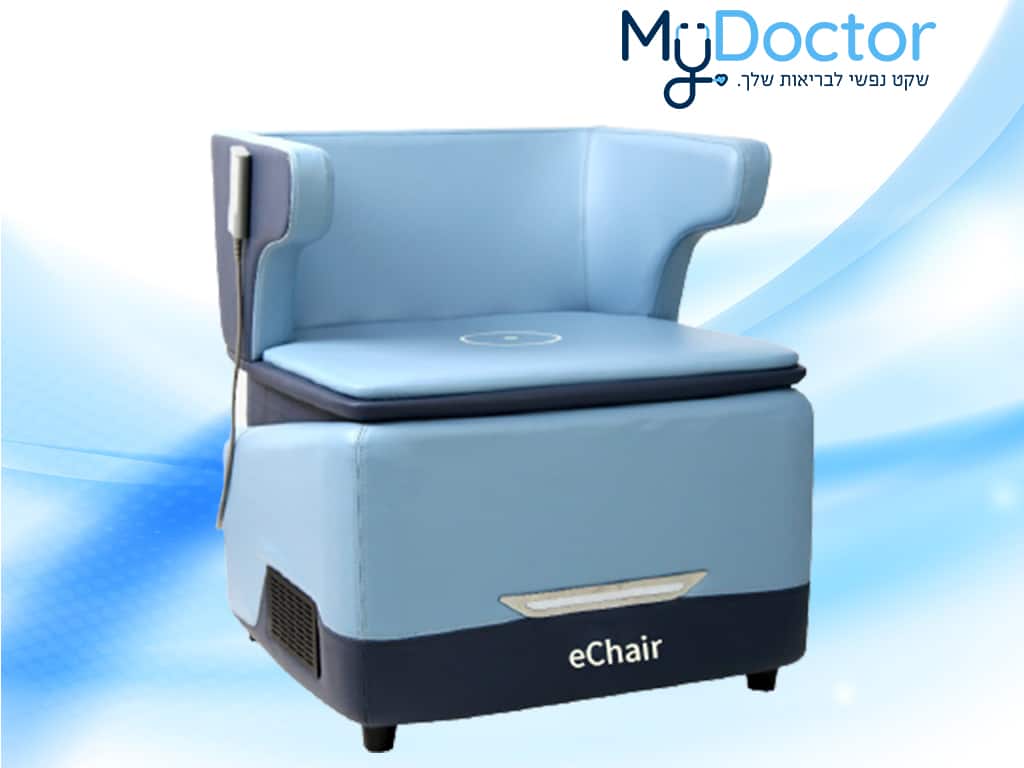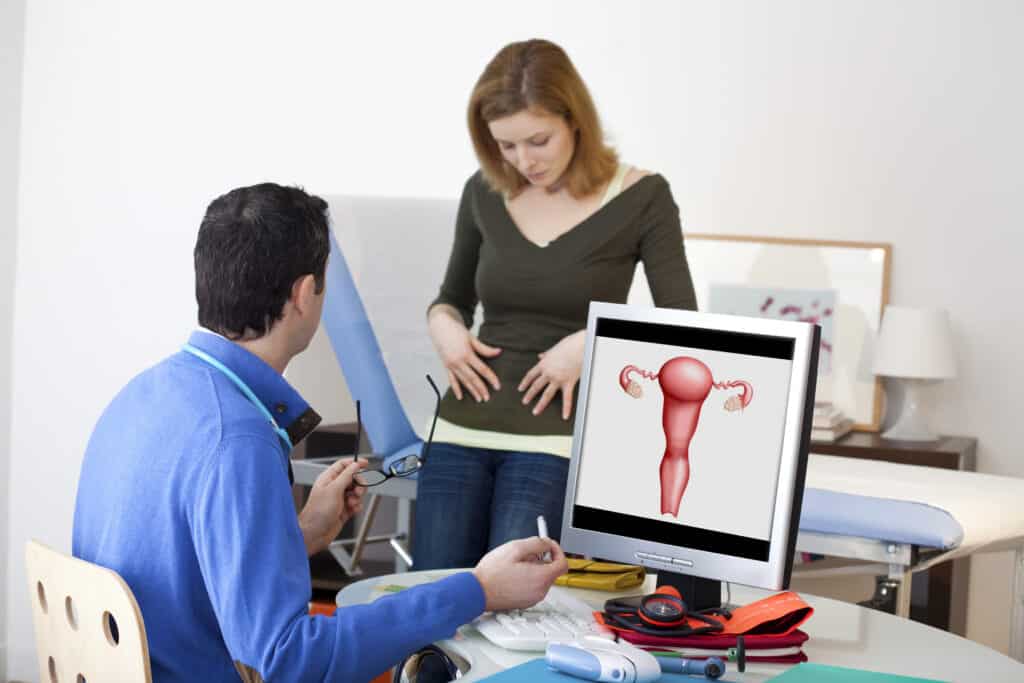Are you dealing with uterine prolapse? Put an end to this phenomenon!
We have a revolutionary and non-invasive solution that will change your life!
A combined treatment of a revolutionary electromagnetic chair that trains and strengthens the pelvic floor muscles + the close accompaniment of a pelvic floor physiotherapist that will save you long months of grueling treatments, in just 6 sessions!
The service is provided at the Pelvic Floor Treatment Center, Tel Hashomer, 4 Gildsagim St., Ramat Gan
A pelvic floor physiotherapist will accompany you throughout the series of treatments
The treatment is non-invasive and takes place fully clothed
The treatment is recognized by Clalit Perfect/insurance companies and they provide reimbursements according to your policy. We will accompany you in receiving the refunds to which you are entitled


היום תורך לשנות את חייך! פגישת ייעוץ מקצועית + טיפול ניסיון עם הרבה ערך For only 149 ₪!

Our Doctors
Dr. Gandhi Bittman

Specialist in General Gynecology, Urgynecology and Pelvic Floor
Dr. Bittman has been an expert in gynecology and urogynecology at Sheba for over 20 years. Performs fistula repair surgeries (the only one in the center of the country that does this using the vaginal method), gynecological surgeries using endoscopic methods (laparoscopy and hysteroscopy), innovative laparoscopic surgeries to correct pelvic organ prolapse, and surgeries to correct urinary leakage.
Our Physiotherapists

Hila Landau - Physiotherapist for pelvic floor rehabilitation and orthopedic rehabilitation
Hila Landau, a physiotherapist for pelvic floor rehabilitation and orthopedic rehabilitation.
She holds a B.P.T in Physiotherapy.
She has diverse clinical experience and a large number of advanced courses in the field of pelvic flooring.
Therapist in pelvic floor rehabilitation, treatment of pain in the relationship, endometriosis, pain during pregnancy and orthopedic rehabilitation.

Noa Nissim - Pelvic Floor Physiotherapist
Noa Nissim, Physiotherapist for Pelvic Floor Rehabilitation and Orthopedic Rehabilitation
Holds a B.P.T in Physical Therapy
She has diverse clinical experience and a large number of advanced courses in the field of pelvic flooring.
Rehabilitation Pilates instructor,
Therapist in female pelvic floor rehabilitation, treatment of pain in relationships, pelvic floor rehabilitation after pregnancy and childbirth, pain during pregnancy, and orthopedic rehabilitation.

Dr. Dana Poudel - Pelvic Floor Physiotherapist
Dr. Dana Poudel is a PhD specialist in physical therapy from Northwestern University Chicago, USA.
Dana has extensive experience in treating pelvic floor problems in women and men, and even combines yoga exercises in the clinic as a holistic treatment for a variety of problems.

Lee Becker - Pelvic floor specialist physiotherapist
Lee Becker is a Razpan Pelvic Physiotherapist certified by the Ministry of Health (BPT), on behalf of the School of Medicine and Health Professions at Tel Aviv University.
Lee has many years of experience as a physiotherapist, including work at the Maccabi Health Fund, the "Ezer Mizion" association and as an anatomy practitioner at the Ono Academic College.
How does it work?

1. Schedule a consultation and adjustment meeting, which includes a medical examination by a physiotherapist specializing in pelvic floor + experiential treatment

2. If you are suitable, schedule a series of treatments using the eChair

3. Embark on a new path with strong pelvic floor muscles that prevent annoying urine odors

4. We will accompany you in receiving reimbursements from your health plan / insurance company
Uterine prolapse
The female population is a population that copes throughout its life with all kinds of problems and situations that characterize it in a special way. In contrast to problems that are common to women and men, there are medical problems that are unique only to women, such as problems related to the reproductive organs, for example. Uterine prolapse is one of the problems faced by many women throughout the country in particular and the world in general, and in fact, it characterizes about 16% of the total population of women over the age of 40. A situation of uterine prolapse is a condition that cannot always be controlled, but there are certainly all kinds of tools that can help to avoid it, and also to deal with it in practice. Today we will tell you a little more information about uterine prolapse, and we will show you all the relevant details that you should know, in the hope that of course you will not have to deal with this situation.

Parachuting Uterus – what is this condition?
When we talk about uterine prolapse, we are talking about a situation in which the uterus, from its natural position, makes a movement towards the vaginal cavity and detaches from its place. In some cases, the uterus will descend into the vaginal cavity, and in other and more severe cases, the uterine prolapse will be expressed by a protrusion outside the vagina.
Uterine prolapse does not simply occur, but there is a clear cause for it. A woman's body has support bands, also known as ligament oil. These support ligaments cause the uterus to be fixed to the pelvic walls, but over the years, due to a variety of activities that take place in the woman's body, they weaken and lengthen. Accordingly, they are no longer able to hold the uterus in place, and this creates a situation of uterine prolapse. This phenomenon is most common after a woman stops getting her monthly period.
The Different Causes of Uterine Prolapse You Should Know
It is now clear to us how a situation of uterine prolapse is created, but it is also useful to understand what are the factors that can cause it to occur at different stages of a woman's life. Three main and particularly prominent factors can be pointed out, the first of which is the age factor.
As a woman gets older, the hormones in her body are secreted in a much poorer and much less intense way. For example, hormones such as estrogen are secreted much less intensely after menopause, and the very lack of estrogen can cause the body's existing connective tissue to weaken and stop functioning properly. Hence, uterine prolapse may be a condition that is only a matter of time before it appears.
Uterine prolapse after childbirth
A second and no less common factor that can cause uterine prolapse is a traumatic birth. Quite a few women experience traumatic childbirth in their lives, because it is a spectrum of situations that can occur during childbirth. For example, a birth in which the baby is unusually large than the size of babies, or a birth in which a variety of accessories are used during the compression stage, are considered traumatic births. As part of these traumatic births, the same supporting ligaments that we mentioned earlier are damaged. This injury causes the ligaments to weaken, and accordingly uterine prolapse may occur.
Uterine prolapse due to genetics and heredity
A third and final factor in the matter is genetic makeup that is related to the woman. Quite a few women are born with a variety of hereditary and genetic factors related to their reproductive organs, one of which can be weakened connective tissue from birth. Once that tissue is weakened in advance, it is only logical that uterine prolapse will occur in women who were born with it, both due to advanced age, traumatic births, and in general.
Uterine prolapse symptoms – how to identify it?
Uterine prolapse, of course, brings with it quite a few symptoms, which will help you identify that this is the condition you are experiencing. It is highly recommended to keep your finger on the pulse and identify the symptoms as early as possible, and accordingly it will be possible to attach appropriate treatment to the situation. Like any health problem, uterine prolapse also brings with it varying levels of severity, which can be mild, moderate, or severe. The symptoms of uterine prolapse will indicate its severity, while the degree of symptoms will also indicate the degree of prolapse. Since this is a deceptive matter, it is important to maintain full attention to the matter, and to know how to identify uterine prolapse even in light of particularly mild symptoms.
Among other things, uterine prolapse will bring with it symptoms such as difficulty or pain during sexual intercourse, a feeling of discomfort or unusual pain in the vagina, difficulty coping with evacuation in the toilet – for the purpose of urinating or defecating, as well as tissue that protrudes outside the vagina.
Each of these symptoms should be a red flag for you, and our recommendation is to seek diagnosis and treatment as quickly as possible.

In order for you to stop imagining uterine prolapse, we are attaching here a photo that will visually illustrate what uterine prolapse looks like, and the procedure itself as it takes place inside the woman's body.
Why is the prompt treatment of uterine prolapse so important?
Uterine prolapse, as can be understood independently, is not a simple condition at all. It brings with it many consequences both in the physical sense and in the emotional and mental sense, and therefore leaving the situation as it is is not only irresponsible, but also has serious medical consequences for the future.
The sooner uterine prolapse is treated, the sooner the woman who suffers from it will be able to return to her normal routine, and will stop suffering from the same consequences that she suffers from while coping with this condition.
Uterine prolapse and the physical effects on the woman who suffers from it
We started talking briefly about the effects of uterine prolapse on a woman's body, and now it's time to expand on them even more. A woman who is dealing with uterine prolapse is a woman who may walk around her daily life with continuous pain. Since no one likes to have pain in their lives on a regular basis, uterine prolapse should be treated immediately.
The very fact of dealing with the pain may lead a woman to avoid a variety of activities in her life, from social activities, through family activities, to independent activities that she likes to do on her own – sports activities, leaving the house for meetings, and more. In fact, such a situation causes uterine prolapse to become the center of a woman's life, preventing her from functioning normally and routinely. Of course, this is not an ideal situation, but immediate treatment of uterine prolapse will prevent it from occurring, or will disappear quickly.
Uterine prolapse and the psychological effects on the woman who suffers from it
Of course, the physical pain is only part of the general picture that uterine prolapse brings. A woman who suffers from uterine prolapse may suffer from particularly severe psychological effects, such as states of depression, anxiety, frustration, helplessness and despair. Since uterine prolapse is indicative of a woman's maturation and difficulties in childbirth, that woman may enter into a mental and emotional loop around her advanced age, around the trauma associated with her birth, and around the frustration that stems from the great pain she experiences on a regular basis.
In light of all this, beyond the physical level, there is no doubt that the mental level is no less important to the matter. A woman who suffers from mental effects as described above and in general, is a woman whose mental state may deteriorate and even become irreversible. There are solutions to all of these, of course, and taking them as early as possible can be a smart, responsible, and healthy step.
Uterine prolapse surgery
One of the first ways to deal with uterine prolapse is through surgery. Uterine prolapse surgery is an operation that can have two different goals: one is to remove the uterus completely, and to deal with uterine prolapse by making it disappear completely. The second is lifting the uterus, and coping with uterine prolapse by returning it to its natural position. Both of these surgery options exist and are common today, and the more relevant of the two will be chosen with the help of the recommendation of the doctor who accompanies you along the way.
The decision can be made with the help of various characteristics that are personally related to each woman individually – a mild or advanced uterine prolapse condition, the characteristics of the woman's previous medical background, and more. It is important to note that both surgeries are relatively safe, and are performed today using the most advanced methods.
More details about uterine prolapse surgery
Uterine prolapse surgery can be done today in two different ways: vaginal surgery or laparoscopic surgery. Vaginal surgery is a more invasive and slightly less modern and advanced surgery, compared to laparoscopic surgery that is performed with the help of an optical fiber, which is used through minor incisions made in the abdominal wall, and maintains minimal invasiveness.
All of the surgeries we have listed – vaginal or laparoscopic, for hysterectomy or lift, are surgeries that are known for their high success rate, their smallest and rarest number of complications, and the simple and quick recovery process that joins them. In light of all these details, it can be understood that uterine prolapse surgery is not something that should be given up, certainly in situations where uterine prolapse is in a difficult situation, and even more so according to its simplicity.
Are there other ways to deal with uterine prolapse without surgery?
The answer to this question is definitely yes. There are two other ways that you should know, the first of which is to insert a vaginal support into the vagina. The role of the vaginal support is to help lift the uterus, and it is intended mainly for women for whom uterine prolapse treatment is not a realistic option. These women are usually those whose medical background does not allow for a successful undergoing surgery, or women whose age is too advanced and too old, which may make the surgery dangerous for them.
Uterine Prolapse Natural Treatment
Another of the two other ways of dealing with Uterine prolapse Non-surgery is a natural way of treatment. Women who choose not to go to surgery or who cannot access it, can definitely choose to change their lifestyle in order to treat uterine prolapse naturally, without the intervention of medical tools or various surgical procedures.
As an integral part of natural treatment for uterine prolapse, you can find a variety of steps that can and should be taken into account:
1. Smoking Outdoors
Women who smoke increase the chance of uterine prolapse in the future. Smoking can impair lung function, and consequently cause a lot of coughing. Coughing is something that causes the pelvic floor muscles to work in a double and double way, so they may weaken significantly over the years and cause uterine prolapse.
2. Normal body weight
Quite a few people may suffer from uterine prolapse due to being overweight. The excess weight may cause pressure on the bladder, pelvic floor muscles, and all the muscles and organs in the lower abdomen, and accordingly, uterine prolapse may occur. Maintaining a healthy body weight through proper nutrition and sports activities can definitely prevent uterine prolapse.
3. Strengthening the pelvic floor muscles
The pelvic floor muscles play a very significant role in keeping the uterus in place, so when they weaken – the likelihood of uterine prolapse may certainly increase. Strengthening the pelvic floor muscles, therefore, is critical to the matter, so it is important to take a variety of actions that can make them stronger.
Physiotherapy Uterine Prolapse – What is Important to Know?
The third clause that we have detailed here above is a clause that you certainly have an important and honorable part in maintaining. The various actions of strengthening the pelvic floor muscles are also called uterine prolapse physiotherapy, as it is an umbrella that includes all kinds of diverse actions that can help you keep the pelvic floor muscles strong and functioning.
Physiotherapy Uterine prolapse is something that is important to be careful about both after the appearance of uterine prolapse and before it appears, so here are some details that are important for you to know in preparation for it.
The relationship between uterine prolapse physiotherapy and strengthening the pelvic floor muscles
The pelvic floor muscles play a central role when it comes to bladder function, prevention of uterine prolapse, sphincter control, and more. Since these are such central muscles, they need to be strengthened throughout the entire process – from younger to older ages, as well as in any medical condition.
Strengthening the pelvic floor muscles can be done in a variety of ways, among which you can find exercises to perform independently from anywhere and at any time. Many women who make sure to strengthen their pelvic floor muscles over the years, by performing the exercises in question, prevent themselves from coping with uterine prolapse, and enjoy an independent, routine and healthiest life. If you also want to look like these women, here are some exercises that are very worth getting to know.
Pelvic floor strengthening exercises – to be performed independently at a time and place that is convenient for you
Now we will tell you about six different exercises that you can perform independently at your convenience and from anywhere in the world. These exercises work on one central and simple principle – contracting the pelvic floor muscles to a maximum state, and then relaxing them. Repeated repetitions of the exercises will cause a more intense contraction of the pelvic floor muscles, and accordingly strengthen them significantly. So what exercises are we talking about here? Let's get started:
Exercise No. 1
This is the elevator exercise, if you happen to train as part of classes such as Pilates, for example, it is very possible that you have met it in the past and have already done it quite a few times. As part of the elevator exercise, lie on a mattress with your arms open to your sides and your legs to maintain a slight spread. From this situation, start contracting your pelvic floor muscles in different stages – in the first stage a slight contraction, in the second stage a moderate contraction, in the third stage maximum contraction and then relaxation of the muscles. The feeling of contraction should simulate an elevator, that is, a feeling in which the muscles climb to a different floor each time.
Exercise No. 2
This is an exercise that should be performed in a standing position, in which the legs should be slightly spread apart and both hands should be pressed to the sides of the body. From this stand, take one of the legs and swing it upwards in a bent direction, until the knee reaches the waistline. During the swing, the pelvic floor muscles should be contracted, and while the leg is lowered back to the mattress, they should be relaxed. From one exercise to the next, you can alternate between the supporting leg and the raised leg.
Exercise No. 3
It is performed while sitting, with the legs slightly spread apart and the arms supporting the whole body while behind the back. From this sitting position, the buttocks and pelvis should be raised upwards, while the pelvic floor muscles are contracted. When you reach the peak of your buttocks, relax your muscles back and sit back on the mattress.
Exercise No. 4
It is also called the cat exercise, after the position in which it is performed – cat standing. In this exercise, you should stand at 6, with straight lines occurring between the shoulder line and the palms, and between the waistline and the knees. From this position, the back should be arched with maximum contraction of the pelvic floor muscles, and then curled back while releasing them.
Exercise No. 5
It is an exercise that must be performed while lying down. While lying down, bend your legs and bring them together, and spread both arms to your sides. From lying down, lift your buttocks and pelvis upwards, while contracting the pelvic floor muscles. After reaching the climax, lower your buttocks and pelvis back onto the mattress, releasing the muscles.
Exercise No. 6
It is an exercise that must be performed in the Mizrahi yeshiva. During this sitting, relax the muscles of the hips and buttocks, and contract the pelvic floor muscles while feeling them rise upwards. Once the maximum contraction point is reached, the muscles must be released and relaxed.
Each of these six exercises can be performed in several rep sets, with a number of repetitions ranging from 10-15 in each set. The very contraction of the pelvic floor muscles will cause them to be significantly strengthened, and will prevent uterine prolapse.
Do these exercises really help?
This is one of the oldest methods for strengthening the pelvic floor muscles, and depending on its independent performance, it can be understood that the results from it may appear after quite a few exercises. Of course, these exercises are great and are recommended to be performed frequently, but today they can be combined with more advanced methods of strengthening the pelvic floor muscles.
The world of medicine is a world that is already constantly moving towards progress and technology, and there is no doubt when it comes to strengthening the pelvic floor muscles – this movement brings with it great results. Today, along with the independent exercises, you can schedule a treatment on the eChair – a revolutionary electromagnetic chair that aims to strengthen the pelvic floor muscles much faster and much more effectively. Here are some details you should know.
eChair – Giving Your Pelvic Floor Muscles the Best
So what is it about here? Well, this wonderful chair is marketed exclusively in Israel by us – MyDoctor. The chair looks like a large, spacious sofa that you can sit comfortably on while it does the work for you.
The treatment on the eChair is actually given as part of a series of treatments, consisting of six different sessions. Each session is 28 minutes long, and all you have to do is just sit in the chair and let it work. So what does it do? Well, more than you might have imagined right now.
The operation of the eChair is comparable to your hundreds of independent exercises
In each 28-minute session, the chair will cause your pelvic floor muscles to perform no less than 11,000 contractions. Accordingly, the number of contractions obtained from the entire series of sessions will reach about 66,000 contractions of the pelvic floor muscles, a number that can only be imagined in independent exercises.
This large amount of contractions will result in a particularly effective strengthening of the pelvic floor muscles, both much faster and with effective long-term results. Therefore, you may want to maintain your independent exercises, but at the same time, it is definitely recommended that you coordinate the series of treatments on the eChair for yourself.
Prevent uterine prolapse with MyDoctor's eChair
Now you understand for yourself that you can take the situation into your own hands, and prevent yourself from dealing with uterine prolapse with just a few treatments. We invite you too Contact Us Call 072-397-2-386 today to schedule your own treatment series. At the beginning of the series, you can meet with a pelvic floor physiotherapist, who will be able to diagnose your condition and tailor a series of treatments that will suit your needs.
From here, you can embark on a wonderful path where you dictate the rhythm and tone to your body, and not the other way around. Our company representatives will be happy to provide you with an answer to any questions that still remain open with you, tell you about our special prices, as well as allow you to raise any questions with them, and get the answer you are looking for in order to get started. Looking forward to your phone call and looking forward to seeing you soon, on the way to your complete health. We'll hear it!
Want to learn more about uterine prolapse?
Our team of experts will be happy to assist you

Fill in your details and we will get back to you as soon as possible!


